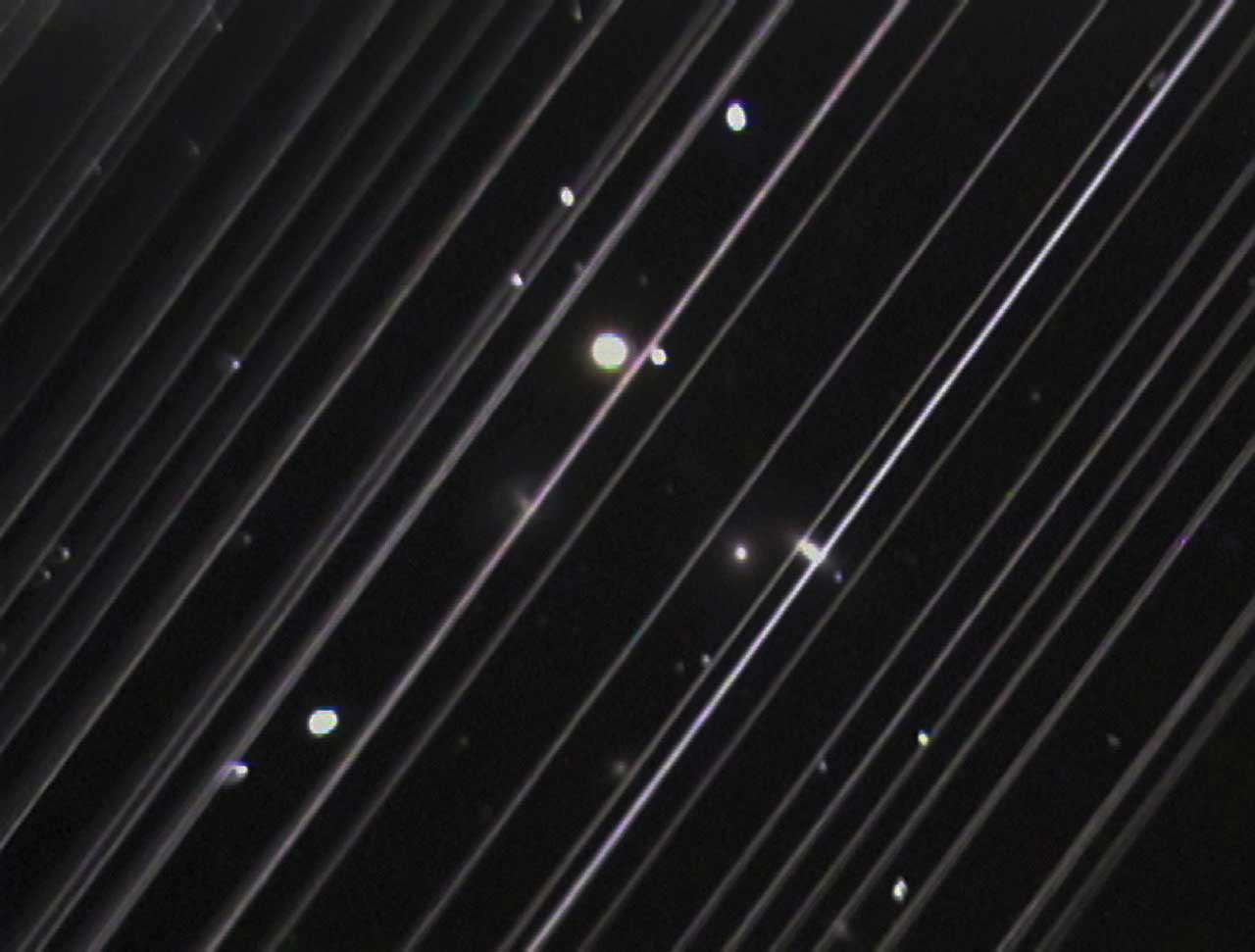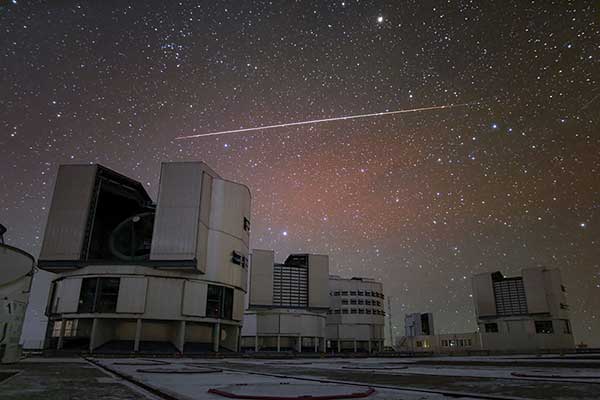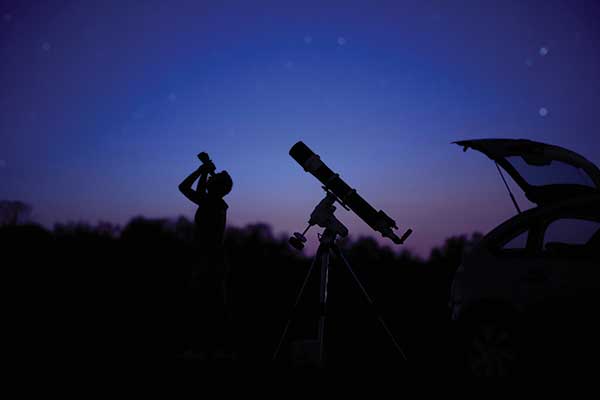Saving Astronomy—and More—in the Age of Technology
“The heavens declare the glory of God;
the skies proclaim the work of his hands.”
So says the writer of Psalm 19. Of course, the psalmist presumed that his readers could see what he saw—the stars, planets, and other bodies that sparkle in the night sky.
Ironically, technological advance has served to decrease the visibility of the heavens and, in some cases, is making observation impossible. Perhaps one reason for diminishing belief in God is that people can’t see much, if anything, of the starry realm through which he speaks.
Ancient Visibility of the Heavens
Nighttime lighting likely dates back to Adam and Eve. The archaeological record indicates that Homo sapiens sapiens (modern humans) always had control over fire. Nighttime camp and hearth fires would have been common. Early written records mention the widespread use of candles and oil lamps.
These early forms of nighttime lighting, however, were intermittent and rarely provided illumination for more than a few hours. The illuminated areas were small, too, usually only about 10 square meters. For pre-Industrial Revolution people, a short walk or a few hours wait would be sufficient to regain views of the nighttime sky.
When God told Abraham to “look up at the sky and count the stars—if indeed you can count them,”1 the night sky on a moonless night was so dark that anyone with good eyes could see about 15,000 stars. Abraham saw the Milky Way and dozens of nebulae, an awe-inspiring sight. The stars spoke to him and his contemporaries of the vastness of the starry realm.
With the invention of the telescope in 1608, humans could see, for the first time, hundreds of thousands of stars. By the late 1600s, millions of stars had become visible.
Lost Visibility of the Heavens
The Industrial Revolution of the 1800s, and especially the technological revolution that followed World War II, had a blinding effect. Artificial nighttime lighting (ANL), such as gas lamps, replaced oil lamps in the 1800s, which meant city streets remained illuminated all night long. By the end of the 1800s, incandescent electric bulbs replaced gas lighting. In the 1900s, incandescent bulbs gave way to mercury vapor lamps, which subsequently gave way to low-pressure sodium lamps. Now, LED lighting is replacing mercury and sodium lamps.
Each advance in ANL has made it brighter, more pervasive, and less expensive. Thus, since 1900, ANL has been increasing exponentially, especially since 2000. Sadly, this twenty-first century rise of ANL has brought with it serious health challenges and ecological consequences.2 At the same time, it has drastically reduced the visibility of the heavens for the majority of the world’s population.
For the first time in human history, most people live in large metropolitan areas. In such places, ANL is so intense that when people look up at the night sky, they see fewer than 50 stars! In some Asian cities not even the brighter planets are visible on a “clear” night. In some of these same cities, the combination of light and air pollution makes seeing the Moon impossible until it rises well above the horizon. So, for hundreds of millions of people, the heavens declare nothing about God. For them, the magnificent heavenly objects remain invisible.
Decreasing Effectiveness of Telescopes
Abraham’s generation did not need telescopes. Our generation does. The availability of telescopes helps compensate for what we cannot see with our unaided eyes. With a good pair of binoculars, we can travel to the countryside to see all that Abraham could see. We can visit the NASA and ESO websites and marvel at images taken by the Hubble Space Telescope (HST), the Very Large Array Telescope, and now the James Webb Space Telescope (JWST).
However, civilization and technology are now threatening the capability of telescopes to see the heavens clearly. How? Satellites now number in the tens of thousands. Within a decade, proposed satellite constellations could raise the number of satellites orbiting Earth to as high as a hundred thousand, even a quarter of a million.

Satellites orbiting Earth reflect sunlight. They create streaks of light across images of the night sky (see figure 1). Especially in the case of long-exposure telescopic images, dozens of satellite streaks brighter than the natural objects astronomers are attempting to observe severely degrade the quality of the research results (see figure 2).

Satellite streaks not only mar ground-based telescope images, they also leave bright streaks across images taken by the HST. In 2021, 5.9 percent of HST images exposed for just 11 minutes were streaked by satellites.3 Deep HST images take hours. The percentage of images marred by satellite streaks rises proportionally with exposure time. You can imagine researchers’ frustration.
As seriously as optical wavelength telescopes are impacted by ANL and satellites, radio telescopes are impacted to a far greater degree. Radio interference from ground-based and satellite transmissions is both strong and pervasive, and it’s only growing. Radio interference seriously limits both short wavelength and long wavelength radio astronomy.4
The research on which I based my doctoral thesis is no longer feasible. For the detection sensitivity required, I used broadband receivers at five different wavelengths. Today, these bandwidths are saturated by radio interference. So research at these wavelengths is now confined to a few narrow “protected” bandwidths.
More Interference from Satellites
In 2020, a team of astronomers calculated the degree of illumination from Earth-orbiting satellites at the zenith (directly above any point on Earth’s surface) at midnight. The skyglow amounted to 20 microcandelas per square meter.5 (One candela expresses the light emitted by a candle of specific size and composition.) This level of illumination already degrades astronomers’ observations.
The megaconstellation satellite systems proposed for launch during the next 15 years will increase midnight zenith illumination by more than ten times. It may become noticeable even to people in rural areas.
Dark Sky Refuges
The International Astronomical Union has appealed to the United Nations Committee on the Peaceful Uses of Outer Space to protect the night sky’s darkness for the sake of future advances in astronomy. While astronomers cannot stop the launch of satellite constellations, the best they can hope for is that corporations manufacturing satellites will make them less reflective.
The one remaining “radio quiet” location in the solar system is the far side of the Moon during the lunar night. However, even this site is under threat. In the next decade or so, the Moon will become the target of hundreds of orbiters and landers. These orbiters and landers could spoil radio astronomy’s last remaining refuge.6
At a conference called Astronomy from the Moon: The Next Decades, held at the Royal Society of London, astronomers raised the alarm. They called on governments to establish international treaties that would protect the Moon’s far side. In particular, they called for the shelving of plans to install a lunar satellite navigation system. They asked that strict rules be applied to any satellite or lander operating on the Moon’s far side. More than 250 lunar missions are scheduled for launch during the next decade. The time window to draft appropriate treaties and acquire necessary signatures is small and rapidly shrinking.
Meanwhile, optical and infrared astronomy research is also being squeezed out. The remaining refuge for these types of observations is the Lagrange 2 point (L2) along Earth’s orbit. This point is about a million miles away from Earth, where the JWST has been operating for the past year. The European Space Agency’s Euclid Space Telescope is on its way to join the JWST in L2.
To place telescopes at the L2 site is not inexpensive. The JWST, for example, cost $10 billion. Furthermore, the L2 site is subject to meteorite and micrometeorite impacts, and L2 is too far away for repair or upgrade missions.
What’s at Stake?
Increasing ANL threatens more serious consequences than interference with the astronomy research I’m passionate about. It will bring more serious health and ecological consequences than those we’re already experiencing. For one example, the Bible speaks of a time when people’s love will “grow cold.”7 It’s easy to see how ANL may be partly to blame.
ANL reduces both the duration and quality of sleep.8 A recent study shows that sleep loss exacerbates depression and reduces expression of altruism.9 Altruism would likely be further reduced and depression further increased as people lose the ability to see the beauty and wonder of God as expressed in the heavens. Much more than astronomical research is at stake.
What Can Be Done?
Technological advances have made ANL, the Internet, and global positioning systems remarkably accessible. The low cost of these amenities tempts humans everywhere to expand their usage. However, the time has come to address significant questions:
1. Can we limit ANL to places where it’s essential for safety?
2. Can we move ANL wavelengths toward the red end of the spectrum, where effects are less harmful?
3. Can we develop technology whereby we need fewer satellites?
4. Can we make satellites less reflective, less “noisy,” and place them in lower orbits?
5. Can we design satellites to de-orbit once they cease to be useful?
6. Can we develop and implement a system for the retrieval and safe disposal of obsolete satellites and space litter?
I believe we can do all these things and more to help restore access to the revelation of God’s glory in the heavens. Personally, I love to show people the gorgeous images being released by space telescopes and explain what they tell us about our Creator.
Although I may seem to be bashing technology, I greatly value it. One particular smartphone app when aimed at the night sky identifies astronomical objects. A good pair of binoculars (e.g., 7x50 or 10x50) can be linked to the smartphone for enhanced viewing of the planets, moons, stars, and nebulae.
The sense of wonder that comes from observing the heavens nearly always leads to in-depth contemplation and conversation about the One who brought them—and us—into existence. •
Notes
1. Genesis 15:5.
2. Hugh Ross, “Is Artificial Nighttime Lighting Too Much of a Good Thing?“ Today’s New Reason to Believe (blog), Reasons to Believe (October 17, 2022).
3. Sandor Kruk et al., “The Impact of Satellite Trails on Hubble Space Telescope Observations,” Nature Astronomy 7 (March 2, 2023): 262–268.
4. Hugh Ross, “LuSEE: Boldly Going Where No One Has Gone Before,” Today’s New Reason to Believe (blog), Reasons to Believe (July 24, 2023).
5. M. Kocifaj et al., “The Proliferation of Space Objects Is a Rapidly Increasing Source of Artificial Night Sky Brightness,” Monthly Notices of the Royal Astronomical Society: Letters 504, no. 1 (June 2021): L40–L44.
6. Davide Castelvecchi, “Are Telescopes on the Moon Doomed before They’ve Even Been Built?“ Nature 615 (March 16, 2023): 383–384.
7. Matthew 24:12.
8. Maja Grubisic et al., “Light Pollution, Circadian Photoreception, and Melatonin in Vertebrates,” Sustainability 11, no. 22 (September 14, 2019): id. 6400.
9. Eti Ben Simon et al., “Sleep Loss Leads to the Withdrawal of Human Helping across Individuals, Groups, and Large-Scale Societies,” PLOS Biology 20, no. 8 (August 23, 2022): id. e3001733.

Keeping the Heavens in View
by Neil English
Having watched the stars since childhood, I empathize with Dr. Ross. The night sky is the last great frontier, but over the decades this wonderful wilderness in the heavens has been retreating from view due to ever more light pollution and the exponential rise in satellites cluttering the sky. If you were to go out on a clear night to observe the stars, wherever you aim your binoculars, you will eventually see one or more artificial satellites moving across your field of view. This was not the case even a decade ago, and professional astronomers are not the only ones sounding alarms. An army of amateur astronomers has also been raising concerns about how light pollution is making it increasingly difficult to observe the stars and forcing them to travel far greater distances to find decently dark night skies.
Astro-photographers using telescopes coupled to sensitive cameras despair at seeing satellite trails ruining their long-exposure images, but all is not lost. Satellite trails can be removed by stacking multiple images to reduce the signal-to-noise ratio of the captured images and enhance objects that are very faint. Some software programs, such as PixInsight, can identify which pixel values fall far away from the mean value of those pixels representing the intended deep sky object being imaged and compare them to similar pixels in other frames. The anomalous pixels can then be removed so they don’t affect the final image.
The rise in artificial light has led to the establishment of several organizations dedicated to tackling the problem. For example, International Dark Sky Places (IDSP) has established more than 200 dark sky locations since its founding in 2001. There are now more than 160,000 square kilometers of protected land in 22 countries spread across six continents, and the list grows every year. Another successful strategy adopted by IDSP is to invest in research and development of artificial lights that project more light downward toward the ground and far less upward toward the sky. While more needs to be done, these are just a few successful measures that have been introduced to alleviate the plague of light pollution so that the heavens may continue to declare the glory of God above cities and towns around the globe.
Hugh RossPhD, is an astrophysicist and the founder and president of the science-faith think tank Reasons to Believe (RTB).
Get Salvo in your inbox! This article originally appeared in Salvo, Issue #67, Winter 2023 Copyright © 2024 Salvo | www.salvomag.com https://salvomag.com/article/salvo67/stars-stricken



















